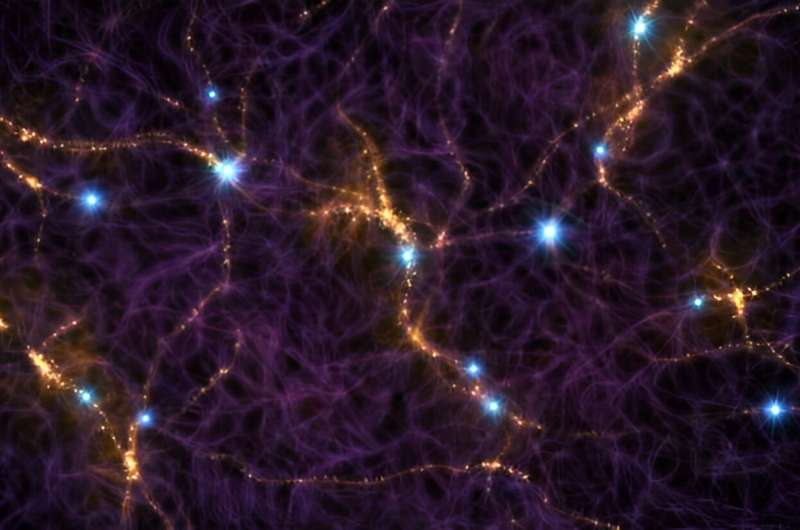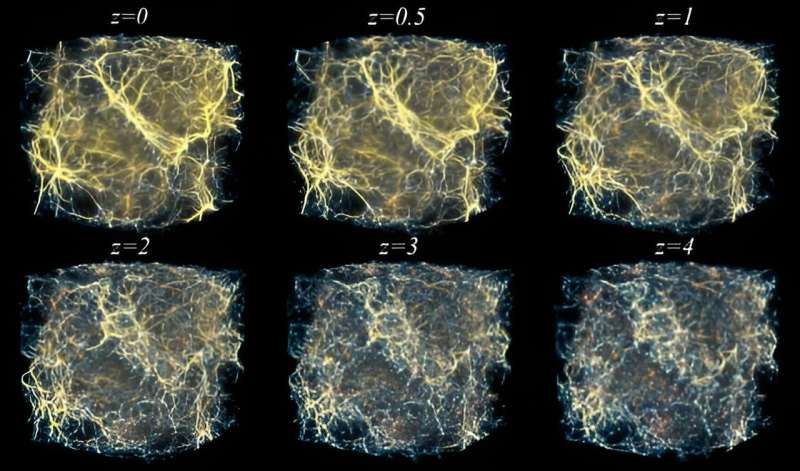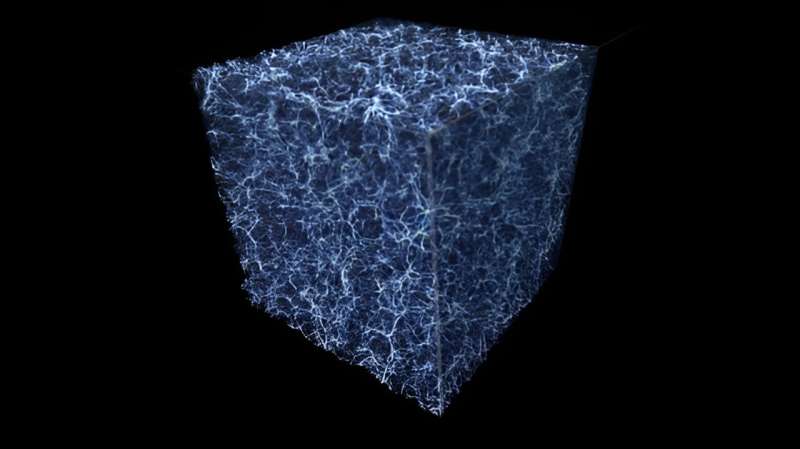This article has been reviewed according to Science X's editorial process and policies. Editors have highlighted the following attributes while ensuring the content's credibility:
fact-checked
peer-reviewed publication
trusted source
proofread
What can slime mold teach us about the universe?

What can slime molds tell us about the large-scale structure of the universe and the evolution of galaxies? These things might seem incongruous, yet both are part of nature, and Earthly slime molds seem to have something to tell us about the universe itself. Vast filaments of gas threading their way through the universe have a lot in common with slime molds and their tubular networks.
The large-scale structure of the universe is made up of galaxies in galaxy groups and clusters. They're surrounded by vast voids, and filaments of gas travel through the voids, linking groups, clusters, and superclusters together. But what effect do the filaments have on the evolution of galaxies?
A team of researchers developed a novel way to identify these filaments and build a catalogue of them. They used the Illustris TNG simulator and a slime mold simulator to help identify the filaments. With a better understanding of where filaments are, they can start to understand what role the filaments play in the evolution of galaxies.
They presented their results in a paper titled "Filaments of The Slime Mold Cosmic Web And How They Affect Galaxy Evolution." The study has been submitted to The Astrophysical Journal, and the paper is currently in pre-press; it is currently available on the preprint server arXiv. The lead author is Farhanul Hasan from the Department of Astronomy at New Mexico State University.
Slime molds are one of nature's most unusual life forms. Some are collective lifeforms that contain an assemblage of different organisms. Somehow, they optimize themselves by spreading tubes across their environment. This allows them to navigate mazes to reach food and to return to an area that previously held food. That's remarkable because they do it all without a brain. Their unusual abilities make them valuable in astrophysics.
One of astrophysics' major goals is to understand how galaxies form and evolve. Astrophysicists measure their masses, their active galactic nuclei feedback, supernovae explosions, and other processes internal to galaxies. But the environment the galaxy is in also determines its evolution. What role do the cosmic web filaments that connect the galaxies play in galactic evolution?
That's at the heart of this study.
"Identifying the salient 'environmental' indicator of a galaxy is a task that has been approached differently in various studies," the authors explain.
"Galaxy evolution can be analyzed in the context of the universe's large-scale structure, known as the 'cosmic web.' This structure consists of an interconnected network of filaments, which are bridges of intergalactic matter, and nodes, which are dense intersections of filaments where the cosmic density distribution is highest," they write.

Galaxy groups, clusters, and superclusters are found within the web, the authors point out, and they're pretty easily identified. However, the individual filaments are much harder to identify, even in a powerful simulation like Illustris TNG. "Identifying the filaments of the cosmic web from a sparse distribution of galaxies, commonly known as cosmic web 'reconstruction,' is a challenging task," the paper states.
This is important because the filaments affect galaxy evolution. Different studies identifying filaments have arrived at different conclusions. "For example," the authors write, "while some studies suggest a suppression of gas and star formation near filaments, others report an increase in gas supply and/or star formation." So, scientists clearly don't have a good understanding of the effects of filaments on galaxies, and it could be because they're misidentifying them or not seeing them all.
That's where slime molds come in.
"Our approach uses a novel model called the Monte Carlo Physarum Machine (MCPM) to estimate the cosmic density field," they write.
The MCPM is a computational tool that reconstructs complex transport networks. As the name says, it's based on the true slime mold Physarum polycephalum. Scientists use P. polycephalum as an unconventional "biological computer" to solve maze navigation problems, design transportation systems, and perform numerous other related tasks. "MCPM is inspired by the feeding habits of the biological organism Physarum polycephalum or slime mold, which is known to generate highly efficient interconnected networks when searching for food," the authors explain.
MCPM's most famous use was when engineers used it to replicate the Tokyo subway system. They arranged oat flakes in a pattern matching the cities surrounding Tokyo, and the slime mold constructed nutrient channels connecting the oats in a pattern very similar to the existing subway system.
In this study, galaxies and clusters took the place of oat flakes. The result? "Our approach has significantly improved the filament identification scheme…" used in other cosmic web reconstructions, the authors write. The researchers highlighted the effect the cosmic web has on both the quenching of gas and the supply of gas to galaxies.
There's another method of identifying filaments scientists use to reconstruct the cosmic web, and it's called the Delaunay Tessellation Field Estimator (DTFE). As part of their study, the authors compared DTFE's performance with the MCPM physarum-based method. "The change in the identified filamentary structure between the two density-field inputs is quite dramatic," the authors state.
The result is that DTFE "… is only successful in connecting more massive galaxies," the study says. MCPM not only connected a greater number of galaxies, but it also identified many more filaments and faithfully traced the underlying dark matter distribution. The MCPM filaments are also more naturally shaped, with more curved lines and fewer sharp turns.

The MCPM tool produced stronger results. But the paper isn't just an evaluation of the tool. The goal is to study how filaments affect galaxy evolution. "Here, we study how the MCPM density field-based filaments of the cosmic web environment affect galactic star formation activity and gas fraction," the paper states.
The results show a stunning difference between the star formation rates in the DTFE field versus the MCPM field. In the DTFE results, galaxies quench as they get closer to the filaments for all stellar masses at low redshift. But in the MCPM field, "… the distance to filaments appears to have almost no effect on star formation of high, intermediate, or low mass galaxies," the authors explain.
There's more. Since the MCPM field is better at identifying less prominent filaments compared to DTFE, the MCPM slime-mold results showed that virtually all galaxies live near a filament. This is in contrast with the previous DTFE results from other research. "Most galaxies are located within a distance of approximately 1.5–2.5 Mpc from the spine of an MCPM filament," write the authors.
Slime molds clearly have something to teach us about the universe we inhabit. The deeper results of this study show that star formation was at similar levels both close to and distant from MCPM filaments in early epochs of z~2. "This provides evidence that filaments at early times can efficiently supply gas into galaxies, which allows them to grow quickly," the authors summarize. This result plays into recent results from the JWST showing that massive galaxies were present in the early universe.
But things change later in the universe. The simulations show that thicker filaments actually quench the star formation rate by reducing the gas supply to galaxies in the last 10 billion years.
Understanding how galaxies grow and evolve is one of astrophysics' primary goals. This study, with the help of slime molds, sheds light on how it all works. But the future might be even more exciting when it comes to slime molds and astrophysics.
"Perhaps even more exciting is that our new method can be applied to observational datasets to identify the cosmic web structure in the real universe," Hasan and his colleagues write. We're poised to get even better datasets from telescopes like the JWST, Euclid, the Roman Space Telescope, and others.
Researchers can rely on one of nature's most unassuming life forms to help make sense of all that upcoming data.
More information: Farhanul Hasan et al, Filaments of The Slime Mold Cosmic Web And How They Affect Galaxy Evolution, arXiv (2023). DOI: 10.48550/arxiv.2311.01443
Journal information: Astrophysical Journal , arXiv
Provided by Universe Today




















